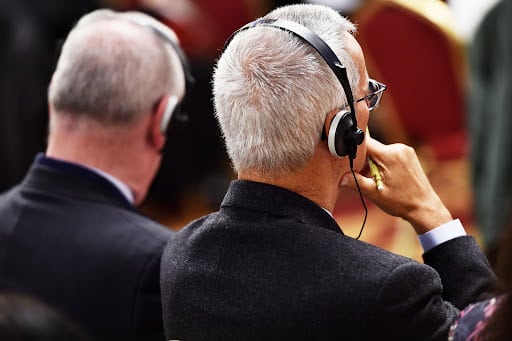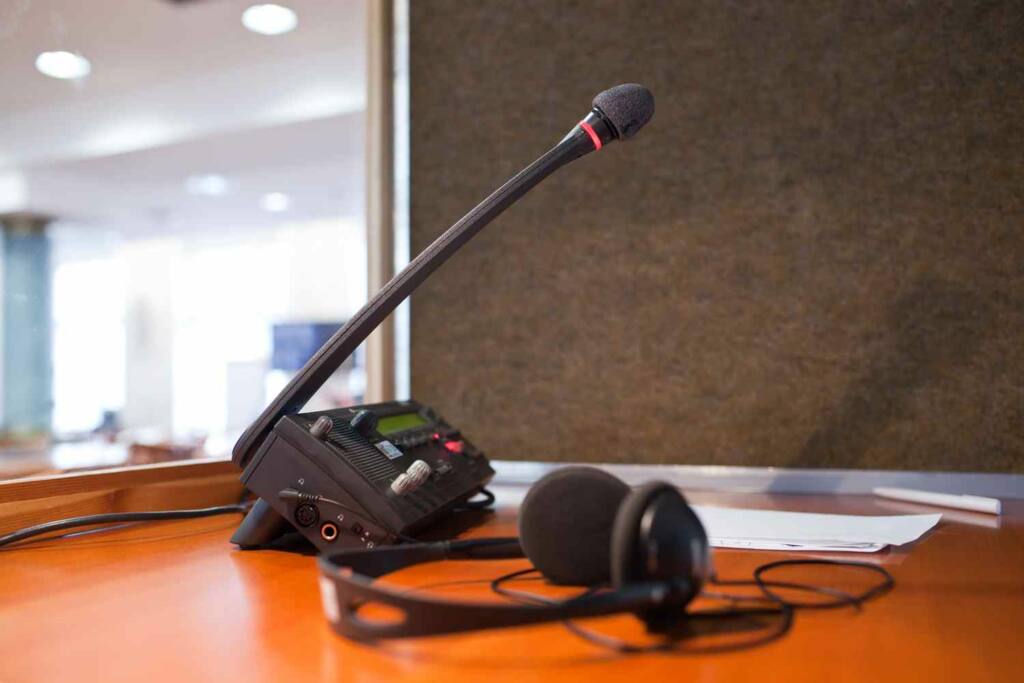At Elbatrad Translations we offer language translation services. We provide services for a wide variety of situations and variants in all the official languages of the world. If you wish to have further information about interpreting in different languages, we are going to explain you everything step by step.

Simultaneous interpreting
Simultaneous interpreting is very common in congresses, fairs and international events. It consists of an interpretation in real time. The interpreter translates at the same time of the speaker’s intervention and this is usually done inside soundproof booths from where they transmit the translation to the entire audience either by radio channels, television or internal system where listeners hear the translation individually usually through headphones.
Usually, several interpreters are needed to work consecutively every half hour in order to have breaks from time to time as it is a job that requires great concentration for long periods of time.
Modalities of language interpreting
Depending on the situation you have to deal with, you will have to choose between one type of interpreting or another. Starting from that point, the different types of interpreting according to the situation are:
Sworn interpreting
They are mainly performed in courts, although they may also be performed in notarial acts or in the private sphere as the case may be.
Only a sworn interpreter can perform this service. In other words, only an expert in the field can translate the legal terms present in court.
Interpreting of events
This includes services such as presentations in another language or the adaptation of any other material prepared for the event. This modality covers a multitude of situations ranging from conferences or weddings to concerts, among many others.
Consecutive interpreting
Consists of interpreting once the speaker has finished speaking, i.e., the interpreter listens and takes notes of what is said as the first person speaks and then translates into the language of the second person.
This type of interpreting is common in large international meetings, symposiums or congresses where there is a large audience even of several languages. This would include individual booths where they work simultaneously in different languages.
Liaison Interpreting
A liaison interpreting is one in which the interpreter accompanies the client and performs the function of liaison between 2 or more persons, acting as a mediator.
It is the most commonly used interpreting modality for negotiations, interviews or appointments with specialists as it facilitates the conversation between both parties.


Whispered Interpreting
This type is usually used in meetings or small groups. The interpreter will be in charge of communicating the client in his mother tongue and in a low voice what is being developed. It is more personal than other modalities and does not require any technical support.
The interpreter stands behind the participants and simultaneously translates into their ears what the second person is saying.
At ElbaTrad we aim to provide you with a quality and very complete service. We adapt to the new times and offer our clients the possibility of choosing an interpreting service in all languages. This is one of our most distinctive marks in contrast with other translation and interpreting companies.
Frequently Asked Questions
What skills should an interpreter have?
An interpreter must have excellent communication skills, both oral and written. He must be able to speak clearly and concisely, as well as to listen attentively to others.
They must also be fluent in the source and target languages and have a thorough knowledge of the subject matter they are interpreting. Interpreters must also be able to remain calm under pressure and think quickly.
What kind of training is required to become an interpreter?
There is no single answer to this question, as the interpreters’ educational requirements may vary depending on the specific field or industry in which they wish to work. However, most interpreters need at least a bachelor’s degree and many choose to obtain additional certification or training.
Interpreter training programs typically cover topics such as linguistics, intercultural communication, and the theory and practice of interpreting. Many programs also include an internship component, which offers students the opportunity to gain real-world experience working with clients.
What is the difference between a translator and an interpreter?
A translator is someone who translates written texts from one language to another, while an interpreter is someone who interprets spoken or signed language in real time. The main difference between these two professions is the medium they work with. Translators usually work with written texts, while interpreters work with spoken or signed languages.
There are other key differences between translators and interpreters. Translators usually have more time to complete their work, as it is not done in real time. This allows them to thoroughly research concepts and words to ensure that the final translation is accurate. Interpreters, on the other hand, must be able to understand and convey meaning quickly and accurately.
